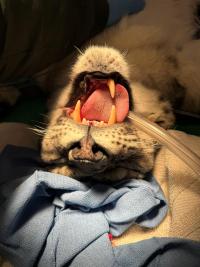
Exotics and Dentistry and Oral Surgery Teams Collaborate to Treat Snow Leopard’s Fractured Tooth
“Case of the Month” – February 2024
Caretakers at the Micke Grove Zoo in Lodi recently noticed a fractured canine tooth on their 10-year-old female snow leopard, Trini. With her annual examination approaching, the zoo addressed the dental issue at that appointment with the UC Davis veterinary hospital’s Companion Exotic Animal Medicine and Surgery Service, which provides most veterinary needs for the zoo’s 130 animals.

To ensure Trini would receive the best dental care, the exotics team collaborated with the hospital’s Dentistry and Oral Surgery and Anesthesia Services. Since the zoo has an onsite clinic suitable for surgery, the safest option was to have the UC Davis team travel to Lodi instead of transporting the leopard.
During previous examinations, Trini was sedated from afar with a dart, but her keepers worked diligently on behavioral training that allowed for a first-time hand injection to immobilize her. Thanks to successful directional training, her care team taught her to move to her bench, where she was injected, then called her to the safety of her den before she became too sedated. The 75-pound leopard was then quickly moved to the clinic where the anesthesiologists immediately prepared her for oral surgery.
“While Trini is a fluffy and beautiful animal, she is also a dangerous predator, and her annual examination and dental procedure could only be performed safely while she was under general anesthesia,” said Dr. Krista Keller, associate clinical professor of exotic animal medicine. “Our anesthesiologists did a tremendous job of keeping Trini and everyone else safe during the surgery.”
The team had initially hoped to perform a root canal treatment to address Trini’s cracked tooth, but unfortunately, she was not an ideal candidate for that procedure. Beyond the large, left mandibular canine tooth that needed to be removed, dental evaluation and x-rays showed that Trini also had three fractured incisor teeth, all of which were extracted without complication to reduce pain and to prevent future infection. All other aspects of her annual examination found her to be in excellent health.

The following morning, Trini awoke alert and comfortable in a smaller den space where she spent the night. For the next four weeks, she was maintained on an altered diet. While Trini continued to eat her soft food diet specially designed for large cats, she was kept off her allotment of bones twice per week to allow for adequate healing of the tooth extraction sites. The nutrients normally received from bones and other treats like pumpkins were supplemented in her food during this time.
The zoo reported that Trini showed no evidence of discomfort in her mouth after returning to her normal diet, as she made a full recovery.
Trini was born in May 2013 at the Albuquerque Zoo as part of the Association of Zoos and Aquariums’ Species Survival Plan (SSP). Shortly after her birth, it was recommended by the snow leopard SSP that she be transferred to the Micke Grove Zoo, as it is a holding facility for the program. The SSP does not have any breeding plans for Trini, as her genetics are already well represented in the species. It is estimated that there are only 4,500-7,500 snow leopards remaining in the wild in central Asia, with an additional 600-700 in zoos around the world. The International Union for Conservation of Nature currently classifies the snow leopard as vulnerable on its list of threatened species, meaning it faces a high risk of extinction in the wild, but not yet reaching the level of endangered.
Average life expectancy for a captive snow leopard is in the upper teens. Prior to obtaining Trini, the Micke Grove Zoo previously had a snow leopard live to age 21.
Trini is on display nearly every day to inspire zoo patrons. Learn more about her and snow leopards on the Micke Grove Zoo website.
# # #

